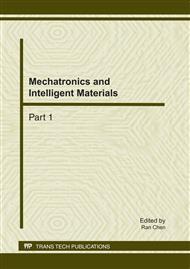[1]
S. G. Kadwane, S. Gupta, B. M. Karan, et al. Practical implementation of GA tuned DC-DC converter. ACSE Journal, Vol. 6, No. 1 (2006), pp.89-96.
Google Scholar
[2]
A. Sahbani, K. B. Saad, M. Benrejeb. Chattering phenomenon supression of buck boost DC-DC converter with Fuzzy Sliding Modes Control. International Journal of Electrical and Electronics Engineering, Vol. 1, No. 4 (2008), pp.258-264.
DOI: 10.5772/15151
Google Scholar
[3]
L. Guo, J.Y. Hung and R. M. Nelms. Design and implementation of a digital PID controller for a buck converter. Proceedings of the 36th Intersociety Energy Conversion Engineering Conference, vol. 1(2001), pp.187-195.
Google Scholar
[4]
V.S. C Racirah and P. C Sen. Comparative Study of Proportional-Integral Sliding Mode and Fuzzy Logic Controllers for Power Converters. IEEE Transactions On Industry Applications, Vol. 33, No. 2 (1997), pp.518-524.
DOI: 10.1109/28.568018
Google Scholar
[5]
R.J. Wai. Adaptive sliding-mode control for induction servomotor Drive. IEE Proc. electr. Power Appl. Vol. 147, No, 6 (2000), pp.553-562.
DOI: 10.1049/ip-epa:20000628
Google Scholar
[6]
S. C. Tan, Y. M. Lai, C. K. Tse. General Design Issues of Sliding-Mode Controllers in DC–DC Converters. IEEE Transactions on Industrial Electronics, Vol. 55, No. 3 (2008), pp.1160-1175.
DOI: 10.1109/tie.2007.909058
Google Scholar
[7]
Y.W. He, W.S. Xu and Y. Cheng. A Novel Scheme for Sliding-Mode Control of DC-DC Converters with a Constant Frequency Based on the Averaging Model. Journal of Power Electronics, Vol. 10, No. 1 (2010), pp.1-8.
DOI: 10.6113/jpe.2010.10.1.001
Google Scholar
[8]
O. Lopez, L G. Vicuna, M. Castilla, et al. Sliding mode control design of a high-power-factor Buck-Boost converter. IEEE Trans on Industrial Electronics, Vol. 46, No. 3 (1999), pp.604-612.
DOI: 10.1109/41.767068
Google Scholar
[9]
J.F. Tsai and Y. P. Chen. Sliding mode control and stability analysis of buck DC-DC converter. International Journal of Electronic, Vol. 94, No. 3 (2007), pp.209-222.
DOI: 10.1080/00207210601176692
Google Scholar
[10]
N. Rajarajeswari, K. Thanushkodi. Design of an Intelligent Bi-Directional DC-DC Converter with Half Bridge Topology. European Journal of Scientific Research, Vol. 22 No. 1 (2008), pp.90-97.
Google Scholar
[11]
Mahdavi, J., Nasiri, M. R., Agah, A., & Emadi, A. Application of neural networks and state space averaging to a DC/DC PWM converter in sliding-mode operation[J]. IEEE / ASME Transactions on Mechatronics, Vol. 10, No. 1 (2005), p.60–67.
DOI: 10.1109/tmech.2004.842227
Google Scholar


